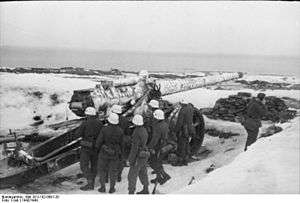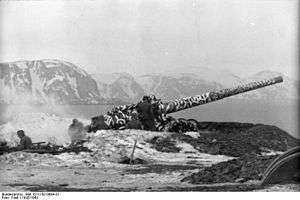Canon de 145 L modele 1916 Saint-Chamond
Canon de 145 L modèle 1916 Saint-Chamond or L 16 St Ch was a French heavy artillery piece designed and produced during the First World War. A number were still on hand during the Second World War and served as coastal artillery in the French and German services.
| Canon de 145 L modèle 1916 Saint-Chamond | |
|---|---|
 A 14.5 cm K 405(f) emplacement in Festung Norwegen. | |
| Type | Heavy artillery Coastal Artillery |
| Place of origin | |
| Service history | |
| In service | 1916-1945 |
| Used by | |
| Wars | World War I World War II |
| Production history | |
| Designer | St-Chamond |
| Designed | 1916 |
| Manufacturer | St-Chamond |
| Produced | 1916 |
| No. built | 200 (WW1) |
| Variants | Canon de 155 L modele 1916 Saint-Chamond |
| Specifications | |
| Mass | Travel: 13,300 kg (29,300 lb) Action: 12,500 kg (27,600 lb) |
| Barrel length | 7.3 m (23 ft 11 in) 48.5 caliber[1] |
| Shell | Separate loading charge and projectile |
| Shell weight | 36.2 kg (80 lb) |
| Caliber | 145 mm (5.7 in) |
| Breech | Interrupted screw |
| Recoil | Hydro-pneumatic |
| Carriage | Box trail |
| Elevation | 0° to +42.5° |
| Traverse | 6°[1] |
| Rate of fire | 1.5 rpm |
| Muzzle velocity | 784 m/s (2,570 ft/s) |
| Maximum firing range | 18.5 km (11.5 mi)[1] |
History
The French Army had been pursuing the replacement of the Canon de 155mm L Mle 1877 de Bange gun since 1909. Spurred by the events in the Russo-Japanese war of 1904-5 it was realised that relying on an old gun which was almost immobile for long range artillery support wasn't a viable strategy. The French Army Artillery Technical Committee produced requirements for a de Bange replacement in November 1909. The requirements included two different guns with a range of 13 to 14 km with a maximum elevation of 35 to 40 degrees and a modern mobile carriage. It was suggested the requirement could be met by modification of existing equipment (i.e. the de Bange gun). The 1909 requirement was replaced by a February 1913 one created by a committee headed by General Lamothe. The requirements included a longer range of 17 to 18 km, a calibre of 130 to 140mm and the gun was to be transportable in two loads.[2] However, little was done before the outbreak of WW1. After the outbreak of war about 120 Canon de 155mm L Mle 1877/1914 Schneider guns which used the 155mm de Bange barrel were ordered.[3]
In order to address the French Army's deficit of long range heavy artillery the obvious conversion of suitable calibre Naval guns to land use was undertaken. There were surplus Canon de 138 mm Modèle 1891 guns which had been the secondary batteries of pre-dreadnaught battleships. The in service Canon de 138 mm Modèle 1910 was also converted to land use. Both FAMH (Saint-Chamond) (Mle 1891 - 12 guns) and Schneider (Mle 1910 - 15 guns) [4] produced land carriages in early 1916 and mid 1917 respectively. Although these guns generally met the range requirements of the French Army the carriages were heavy, clumsy and slow firing.[5] Saint-Chamond also constructed 12 Canon de 145mm Mle 1910 sur affût Saint-Chamond in 1916 using bored out 14 cm (138.6mm) Mle 1910 L/55 barrels.[6]
The final adaptation of the 14 cm Naval gun to land use was the Canon de 145 L Mle 1916 Saint-Chamond where new, slightly shorter (L/48.5), barrels were constructed by the Fonderie de Ruelle [7] and mounted on a Saint-Chamond carriage. The barrels were delivered in 145mm calibre with an option to bore them out to 155mm when they wore out although this wasn't done during WW1. The box trial was fairly conventional except for a pair of semi-circular plates at the front of the carriage. Because the gun used the cradle, recoil and recuperators of the Naval gun there was some residual recoil which was not absorbed by the carriage. The practice was to place a pair of inclined ramps under the circular plates so the gun could ride up on these during firing and slide back down into battery. The gun was normally moved as a single unit towed by a 4-wheel drive heavy truck with auxiliary wheels under the end of the trail. It was found the 145mm Saint-Chamond gun was very accurate with very little dispersal of shots. 200 barrels from Ruelle and 160 carriages from Saint-Chamond were ordered in 1916 [8] and the gun entered service in April 1917. This gun along with the Canon de 155mm GPF made up the equipment of the RALTs (Regiment d'Artillerie Lourdes à Tracteur) which made the heavy French artillery so effective at the end of the war.[9][10] The 145mm guns were converted to 155mm in the 1920s and served in heavy artillery regiments until WW2.
After the fall of France in 1940, it is estimated 210-215[11] guns were captured by the Germans. In German service they were known as the 14.5 cm Kanone 405 (f) or 14.5 cm K 405 (f) and employed in Atlantic Wall defenses in German occupied Western Europe.[1]
Photo Gallery
| Wikimedia Commons has media related to Canon de 145 L mle 1916 Saint-Chamond. |
| Wikimedia Commons has media related to HKB 5/480 Mehavn. |
_(cropped).jpg) A Mle 1916 in firing position during World War I.
A Mle 1916 in firing position during World War I._(cropped).jpg) A Mle 1916 in traveling position during World War I.
A Mle 1916 in traveling position during World War I._(cropped).jpg) A Mle 1916 with its limber during World War I.
A Mle 1916 with its limber during World War I. A Mle 1916 in Norway during World War II.
A Mle 1916 in Norway during World War II. A Mle 1916 on a Panama mount in Norway during World War II.
A Mle 1916 on a Panama mount in Norway during World War II. A Mle 1916 on a Panama mount near Cherbourg France.
A Mle 1916 on a Panama mount near Cherbourg France.
References
- Chamberlain, Peter (1975). Heavy artillery. Gander, Terry. New York: Arco. p. 11. ISBN 0668038985. OCLC 2143869.
- Vauvillier, François "Le 155 GPF (Grande Puissance Filloux)", Guerre, Blindés et Materiel, No.81, Févier-Mars 2008, pp. 18-25
- Vauvillier, François "Le 155 GPF (Grande Puissance Filloux)", Guerre, Blindés et Materiel, No.81, Févier-Mars 2008, p.20
- "Règlement Provisoire de Manoeuvre de l'Artillerie Lourde - Disposition Spéciales aux Batteries Armée de Canon de 14 c/m Modèle 1910 sur affût Schneider" (PDF). BnF Gallica. Retrieved 29 October 2017.
- Touzin, Pierre and Vauvillers, François "Les Canons de la Victoire 1914-1918 Tome 1", Histoire & Collections, Paris, 2006, p.50
- Touzin, Pierre and Vauvillers, François "Les Canons de la Victoire 1914-1918 Tome 1", Histoire & Collections, Paris, 2006, p.51
- Fonderie de Ruelle
- Vauvillier, François "1914-1918 La marine au Secours de l'Artillerie Lourde à Tracteurs - II - Les Constructions Neuves - Le Canon de 145 Modèle 1916 Ruelle-Saint-Chamond", Guerre, Blindés et Materiel, No. 86, Janvier-Févier-Mars 2009, pp. 38-46
- Touzin, Pierre and Vauvillers, François "Les Canons de la Victoire 1914-1918 Tome 1", Histoire & Collections, Paris, 2006, p.52
- "Règlement de manoeuvre de l'artillerie - Titre Vg - Description et Entretien des Matériels de 145 et de 145/155 Mle 1916" (PDF). BnF Gallica. Retrieved 29 October 2017.
- "Lexikon der Wehrmacht". www.lexikon-der-wehrmacht.de. Retrieved 2017-10-16.